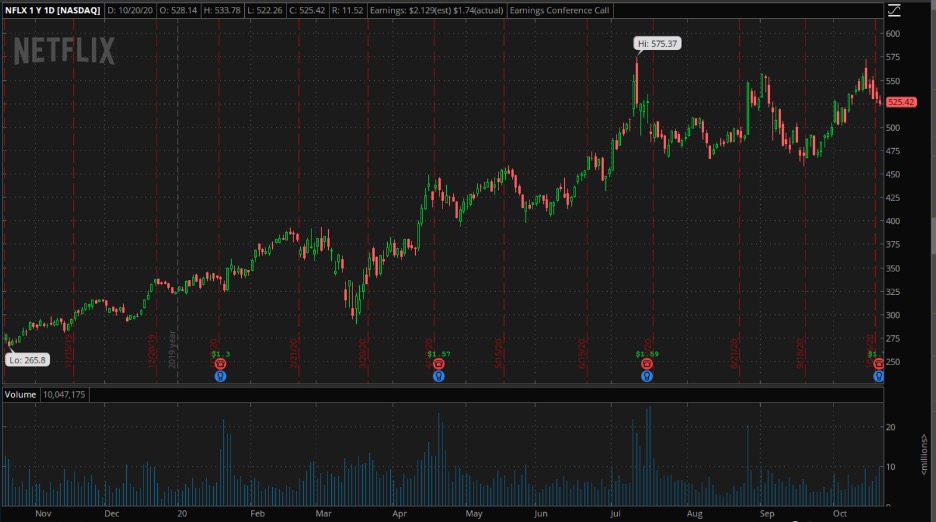Netflix (NFLX) released earnings after the bell yesterday, and their stock immediately dropped around five percent. On that basis, you would think that the report was really bad, and an initial glance at the headline number would seem to confirm that. However, if you look a little further and put the news in context, Q3 wasn’t that bad for NFLX at all. The reaction is more about exaggerated expectations than performance and some investors, I’m sure, are experiencing a bit of déjà vu at this point.
You see, basically the same thing happened a couple of quarters ago. When Netflix released their Q1 earnings back in April, they showed a small beat on revenue, but a miss on EPS, the same as they did yesterday. Back then, I made the point that, in their business and given where the money went, that wasn’t a bad thing at all. Using what was always going to be a short-lived, if massive, boost to revenue during the lockdown to invest in core content was, I said then, a smart move that would pay off over time. Lower than expected margins may not seem like a good thing, but in the exceptional circumstances of a pandemic, they were.
Even after a significant pullback over the last week, NFLX is up over 26% from when I wrote that, so it seems that the market reluctantly agreed with that assessment.
There is one major thing that is different this time around, though. April’s numbers included the early signs of increased subscriptions as more people stayed at home, whereas this time there was a significant slowing in subscriber growth. I’m sure that is the main thing motivating the sellers, but equally sure that it is extremely frustrating for CEO Reed Hastings and the rest of the management team at Netflix.
They, after all, have ben saying since the surge in subscribers started in the spring that it would be temporary, and have even said on a few occasions that they expected that boost to end in Q3. The market, however, thought it knew better, and continued to trade NFLX as if it could maintain massive subscriber growth forever. Now traders are punishing Hastings and his gang for daring to be right by selling off the stock when their prediction proved accurate.
That is plainly ridiculous.

Of course, it does mean that NFLX had got a bit ahead of itself at the highs, but then so had the market overall at that point and a pullback looks healthy.
The real question for investors, as always, is what will happen from here, and on that front, a repeat of what we saw in April definitely looks on the cards.
NFLX was part of the “stay at home” trade that identified stocks that would benefit from rather than be hurt by a move to keep people at home as the pandemic raged. The assumption was that that would be sort-lived, but now, with Covid-19 resurgent, there is a chance that we will be subjected to restrictions again before long.
If you think that is impossible, think about what will happen after the election. Regardless of who wins, both nationally and locally, lawmakers and executives will shift their focus from keeping people happy in the short term to protecting them over the longer-term. That is the difference between the beginning and end of political terms of office. In terms of Covid-19, that means that taking the short-term pain of another round of restrictions rather than risk the political fallout from overflowing ICUs and another couple of hundred thousand dead voters is the obvious choice. (Please excuse my cynicism, but I gave up on expecting anything other than political calculations from politicians in power a few years ago, and will stay that way until someone proves me wrong.)
There are some eerie similarities between NFLX’s earnings released yesterday and those reported six months ago. In both cases, what were good revenue growth numbers got lost in a panic about margins and some trepidation about growth rates. In both cases, though, the low margins were about investment, not profligacy, and expectations for growth that were unrealistically high at a time when predictions were hard if not impossible.
It is therefore likely that when we look back again six months from now, there will be another similarity. NFLX will show good, if not spectacular gains over that period, and we will all be scratching our heads, wondering what the panic was all about.
The views and opinions expressed herein are the views and opinions of the author and do not necessarily reflect those of Nasdaq, Inc.

